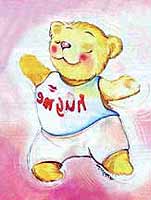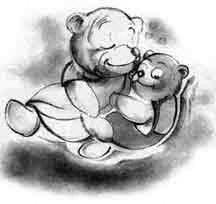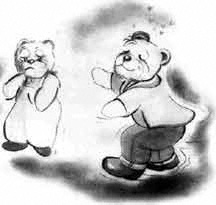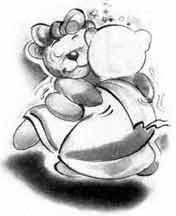- Home
- Archive -Nov 1996
- Have you hugged. . .

Have you hugged anyone lately
- In :
- Personal Growth
November 1996
By Parveem Chopra
We need 4 hugs a day for survival. We need 8 hugs a day for maintenance. We need 12 hugs a day for growth
—Virginia Satir, family therapist
You may laugh off the predilection of the psychiatry community in the USA for coining names such as dance or walk therapies, which are based, on pure common sense or on practices that have always been around in various cultures. But then you may feel like giving them a hug.
 |
For by calling it a therapy, giving it a name, and ardently promoting it, they often manage to create awareness about a healthy and wholesome habit that is endangered by the bustle of modern life. Hug therapy is a typical example.
Big deal, you say, when you hear the term for the first time. But try to recollect the last time you hugged somebody or somebody hugged you. In all likelihood, it was too long ago. Worse, the answer may be ‘never’ if you are the kind who flinches from physical contact.
Truly, urban India is becoming more of a hands-off culture. ‘It is unfortunate because Indians were never averse to touch,’ laments Dr Achal Bhagat, a Delhi-based psychiatrist, ‘particularly when sharing grief or joy.’ The hugging or pecking on the cheek you see nowadays at parties is very superficial, adds Delhi socialite Pommi Malhotra. She has a name for it: social hugging. And its practitioners obviously do not belong to the circle of healing huggers.
So what are we missing out on?
Reaching out and touching someone, and holding him tight—is a way of saying you care. Its effects are immediate: for both, the hugger and the person being hugged, feel good.
‘Touch is an important component of attachment as it creates bonds between two individuals,’ says Dr Bhagat. For Malhotra, who describes herself as a friendly, warm, affectionate and demonstrative person, hugging is simply a natural expression of showing that you love and care.
 |
Vikas Malkani, 29, a director at Avis International, an Indian denim wear company, wishes for much more touching and hugging in families, particularly between parents and their grown-up children. He states that it should not be forgotten that your skin is also a sense organ. Every centimeter of it—from the head to the tips of the toes—is sensitive to touch. In the mother’s womb, each part of the fetus’ body is touched by the amniotic fluid, says Malkani, which may be the origin of the yearning for touch all our lives.
‘Cuddling and caressing make the growing child feel secure and is known to aid in self-esteem,’ agrees Dr Bhagat. The tactile sense is all-important in infants. A baby recognizes its parents initially by touch. Malkani points out cultural variations pertaining to hugging: in the West, hugging a friend of the opposite sex is common, while in India you see more physical contact between friends of the same sex.
Hugging comes naturally to Kajal Basu, a 37-year-old journalist. ‘It loosens you up and breaks the bonds of body as well as of society. The more ritualistic ways of greeting people, handshakes and namastes, are designed to keep us apart rather than bring us together,’ he argues.
Sensing the need, many people are creating their own personal growth courses for children. First-time entrants include Excel Training Forum and Sankalp, both run by retired defense personnel in Delhi, India.
R. Chandran, a reiki master based in Mumbai, India, says that hugging is a tool of transformation. ‘Hugging brings people closer to each other. If your relationship with somebody is not working, try hugging him 20 times a day and there will be a significant difference,’ he guarantees. Comparing hugging to reiki , the currently popular touch therapy based on the transfer of energy, he says the area of touch is much larger in the case of hugging and the contact is much more intimate, so the effects are subtler.
Chandran’s reiki initiates remember the tight, prolonged embraces he gives them on meeting! Or parting. ‘My intention in the act is also to transfer energy. The effect is so distinct that people feel the difference,’ he says.
Indeed, many spiritual gurus, such as Mata Amritanandmayi, hug their disciples a lot, perhaps to pass on the divine energy.
Touch has come full circle in the West this century. Time was when parents and hospitals were advised to leave a crying baby alone. Today the pediatricians and psychologists tell us to pick up and cuddle our children. Toys, even teddy bears, whose use has been increasing in the recent decades, are a poor substitute for the human contact needed by children.
In psychoanalysis, developed early this century, the couch symbolized the distance from the patient that the therapist had to maintain. The taboo against touch was broken in the heady 1960s and ’70s by the hippies’ love-ins and professionally by some therapists who introduced it in the encounter groups. Since then many psychological counselors are expanding the definition of ‘hug’ by even patting and massaging their clients in the course of normal therapy. The idea is to add touch to the powers of speech, listening and observation. The argument goes that the client’s skin can perceive care and reassurance.
Dr Bhagat, however, strongly argues against the psychiatrist or psychotherapist touching his patients; ‘The therapist should never cross the boundaries set by the patient,’ he says. Another context of abuse, he points out, is when adults have sexual contact with children on the pretext of touching and cuddling.
 |
But then, hugging is a tool that has to be used with the same care and sensitivity as any other form of therapeutic intervention. In Delhi, Sanjivini, a well-known center that offers help for troubled minds, has a day clinic for schizophrenics where ‘caring’ (involving touch and holding) is routinely used as a therapy. ‘But it is done in a parent-child matrix,’ clarifies Dr Rajat Mitra in charge of Sanjivini, adding that only women volunteers handle female patients and men handle male patients. Mitra explains that schizophrenics are regressed.
‘And when a two-year-old cries, to comfort him, you do not philosophize but hold him on your lap.’
Hugging is being used even as an aid in treating some physical illnesses, following research that it leads to certain positive physiological changes. For example, touch stimulates nerve endings, thereby helping in relieving pain . It is thus not uncommon for a chronic pain patient to be prescribed ‘Therapeutic touch’ which involves placing the hands on or just above the troubled area in the patient’s body for half-an-hour (shades of reiki). This pushes up the hemoglobin levels in the blood, increasing the delivery of blood to tissues, a study at the nursing department of New York University showed. Some nurses’ associations in the USA have since endorsed therapeutic touch.
Any health problem makes the sufferer feel vulnerable, frightened, angry, frustrated and helpless. The patient usually needs to educate himself to make certain life changes. Hugging can give him the positive emotional state necessary to make these changes. In one study, pet ownership was seen to contribute to the survival of heart patients. The inference: the cuddling of pets has a soothing effect that reduces the stress levels in heart attack victims.
Tactile contact is very important for people with certain handicaps and can even be therapeutic. Imran Ali, a visually impaired telephone operator at the Steel Authority of India office in Delhi, says that if somebody says ‘Hi!’ to him, it means nothing to him—a hug does. In Mario Puzo’s latest novel, The Last Don, the heroine named Athena provides her autistic daughter with ‘a hug box’, lying in which gives the child a feeling of being hugged by a person without having to connect or relate to another human being, which is a problem with autistics.
 |
The miraculous way in which hugging works is described in a touching story titled ‘The Hugging Judge’ in Chicken Soup for the Soul by Jack Canfield and Mark Victor Hansen. It is about Lee Shapiro, a retired judge, who realized that love is the greatest power there is and began offering everybody a hug.
Some years ago he created the Hugger Kit. It contains 30 little red embroidered hearts. Shapiro would take out his kit, go around to people and offer them a little red heart in exchange for a hug. Soon, he became a minor celebrity for spreading his message of unconditional love.
Once, accepting a challenge from a local television station in San Francisco, he went ahead and offered a hug to a six-foot-two, 230-pound bus driver, from a community known to be the toughest, crabbiest and meanest in the whole town. Even as the TV cameras whirred, the bus driver stepped down and said: ‘Why not?’
But Shapiro was queasy when invited to a home for the terminally ill, severely retarded and quadriplegic. Accompanied by a team of doctors and nurses, he went about his routine of hugging and handing out little red hearts till they reached a ward with the worst cases. The last person, named Leonard, whom Shapiro had to hug, was drooling on his big white bib; There’s no way we can get across to this person, Shapiro thought.
But finally he leaned down and gave Leonard a hug. This is what followed, in the authors’ words:
All of a sudden Leonard began to squeal: ‘Eeeeehh! Eeeeehh!’
Some of the other patients in the room began to clang things together. Shapiro turned to the staff for some sort of explanation, only to find that every doctor, nurse and orderly was crying.
Shapiro asked the head nurse: ‘What’s going on?’
Shapiro will never forget what she said: ‘This is the first time in 23 years we’ve ever seen Leonard smile.
It only takes a hug, a heartfelt and warm embrace, to change the lives of others. Try it, it works.
To read more such articles on personal growth, inspirations and positivity, subscribe to our digital magazine at subscribe here
Life Positive follows a stringent review publishing mechanism. Every review received undergoes -
- 1. A mobile number and email ID verification check
- 2. Analysis by our seeker happiness team to double check for authenticity
- 3. Cross-checking, if required, by speaking to the seeker posting the review
Only after we're satisfied about the authenticity of a review is it allowed to go live on our website
Our award winning customer care team is available from 9 a.m to 9 p.m everyday
The Life Positive seal of trust implies:-
-
Standards guarantee:
All our healers and therapists undergo training and/or certification from authorized bodies before becoming professionals. They have a minimum professional experience of one year
-
Genuineness guarantee:
All our healers and therapists are genuinely passionate about doing service. They do their very best to help seekers (patients) live better lives.
-
Payment security:
All payments made to our healers are secure up to the point wherein if any session is paid for, it will be honoured dutifully and delivered promptly
-
Anonymity guarantee:
Every seekers (patients) details will always remain 100% confidential and will never be disclosed

Hugging may sound like the simplest thing on earth, but it will help to keep a few things in mind. Non-hugs are no good. In his book Caring, Feeling, Touching, Dr Sidney Simon describes five non-hugs:
I. The A-frame hug, in which nothing but the huggers’ heads touch.
2. The half-hug, where the huggers’ upper bodies touch—while the other half twists away.
3. The chest-to-chest burp, in which the huggers pat each other on the back, defusing the physical contact by treating each other like infants being burped.
4. The wallet-rub, in which two people stand side-by-side and touch hips.
5. The jock-twirl, in which the hugger, who is stronger or bigger, lifts the other person off the ground and twirls him.The real thing, the full body hug, touches all the bases. Dr Simon describes it like this: ‘The two people coming together take time to really look at each other. There is no evasion or ignoring that they are about to hug… You try as hard as you can to personalize and customize each hug you give… With a full body hug there is a sense of complete giving and fearless. Communication, one uncomplicated by words.
‘It is the attitude that is important,’ says Vikas Malkani. ‘It need not be a full, frontal hug. It could be sideways. Generally, hug only friends and people you know.’
‘Many people do not like their personal space to be invaded. Still others may feel too vulnerable at times to like to be touched,’ warns Dr Bhagat.
The stereotype of men being less demonstrative than women in their love and affection is by and large true. ‘But men are more open to hugging after a few drinks at parties,’ says Pommi Malhotra. From her experience she says that even the tough ones respond to hugging.
Many people feel embarrassed or uncomfortable when hugged, but Malkani’s advice is to still go at it because they are bound to feel good afterwards and may even feel grateful to you. When you feel the need to be hugged, ask for one. Any place is good enough for hugging: home, office, school, church, a party, a conference. You may, however, feel uncomfortable hugging, for example, at work. In that case, prefer a more intimate environment, such as at home with friends or at a party.